
Edmund Reitter was an Austrian entomologist, writer and a collector.

Canacidae, incorrectly Canaceidae, or beach flies, surf or surge flies, is a family of Diptera. As of 2010, 307 species in 27 genera. The family now includes Tethininae as a subfamily.
The Netherlands Entomological Society was founded in 1845 for the purpose of improving and promoting entomology in the Netherlands. The society has more than 600 members.
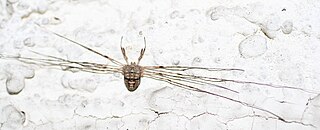
Dicranopalpus is a genus of harvestmen with twelve known recent species. Three fossil species have been described, all from Baltic amber, but only D. ramiger is currently considered valid.

Nabis lineatus is a species of damsel bug in the family Nabidae.
Mapaoni River is a river of Amapá state in Brazil. It is a tributary of the Jari River, which is part of the Amazon River basin.
Ectoedemia hadronycha is a moth of the family Nepticulidae and belongs to the Fomoria subgenus of Ectoedemia. It is endemic to Australia, where it is found along the north-eastern coast of Queensland.

Chrysolina fastuosa, also known as the dead-nettle leaf beetle, is a species of beetle from a family of Chrysomelidae found in Europe, Caucasus and northern Turkey.
Alexey Nikolaievich Diakonoff, also transliterated as Alexej Nikolajewitsch Diakonoff, was a Russian–Dutch entomologist who specialised in Microlepidoptera.

Casimir Albrecht Willem Jeekel (1922–2010) was a Dutch myriapodologist and entomologist known for his major contributions to the taxonomy of millipedes. His 1971 monograph Nomenclator Generum et Familiarum Diplopodorum is credited as launching the "modern era" of millipede taxonomy, and has been considered the "most important single work ever published on the Diplopoda". He served as director of the Zoological Museum Amsterdam, and authored over 150 works on the taxonomy of millipedes and other myriapods.

Sphaeropoeus hercules is a species of giant pill millipede belonging to the family Zephroniidae.
Paratorna dorcas is a species of moth of the family Tortricidae. It is found in Indonesia (Java) and India (Assam).
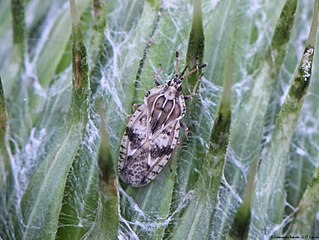
Tingis cardui is a Palearctic lacewing bug. The species is widespread in almost all of Europe and lacking only in the far North. It is common also in North Africa and East Asia minor and the Middle East as well as southern Russia and the Caucasus to Siberia and the North of China. Tingis cardui lives on Cirsium, in particular on Cirsium vulgare, but also on Cirsium palustre and less frequently on Carduus nutans, Carduus crispus, and Carduus acanthoides. Overwintering occurs as an imago in the ground litter, or under loose bark. The bugs appear in April or May, and sit on the basal leaves of their food crops.
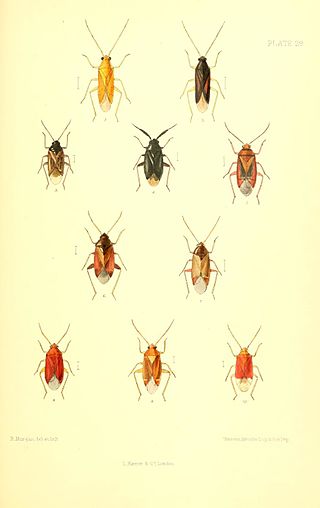
Psallus haematodes is a species of true bug. It is primarily distributed in the Palearctic region, occurring extensively throughout Europe, but its presence is limited to the northern parts of the Mediterranean. Its range extends to Siberia and the Caspian region in the east. The species has also been introduced in North America. Psallus haematodes is typically found in various habitats, including open and sunny areas, as well as shady places near wetland edges, rivers, bogs, and even dry environments.
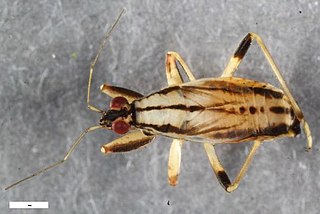
Himacerus boops is a species of damsel bug in the family Nabidae. It is found from South Scandinavia and the South of the British Isles over Western and Central Europe and East across the Palearctic to Siberia and in the Caspian region. They are not present in most parts of the Mediterranean.
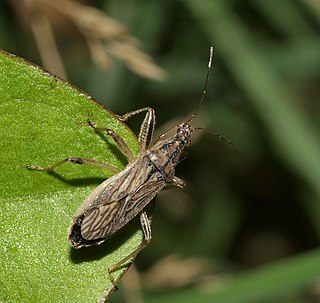
Himacerus major is a species damsel bug in the family Nabidae. It is found in the Holarctic. The range is from South Scandinavia and the South of the British Isles over West Europe including the Western Mediterranean, Central Europe and Eastern Europe and in the Caucasus. It is also found in North America. Himacerus major occurs in many different habitats with grass, regardless of the level of humidity. The species occurs on very dry dune habitats, and nutrient-poor grasslands,as well as wet shores of waters without woody vegetation and salt places inland. The species occurs in very large numbers near the coast of the Northern Baltic Sea. It is absent from woodland.
Dr Anthonie Johannes Theodorus Janse, also known as Antonius Johannes Theodorus Janse and by other orthographic variations, was a pioneer of South African entomology who specialised in Lepidoptera. His multi-volumed work, The Moths of South Africa is recognized as a definitive text.

The Nederlandse Vereniging voor Veganisme or NVV is a Dutch association which strives to promote the vegan lifestyle, and to end animal exploitation. The association was founded on 8 September 1978 in Arnhem as the Veganistenkring, the first organisation in the Netherlands of its kind. Shortly thereafter, its name was changed to Vereniging Veganisten Organisatie, finally adopting its present name in 1987.

Chrysanthus Janssen OFMCap, also known as "Father Chrysantus", born Wilhelmus Egbertus Antonius Janssen, was a Dutch priest and biology teacher. He was known for his studies in arachnology. Initially he was concerned with the spiders of the Netherlands but he became a specialist on New Guinea spiders. Two spider species were named in his honor following his death.













